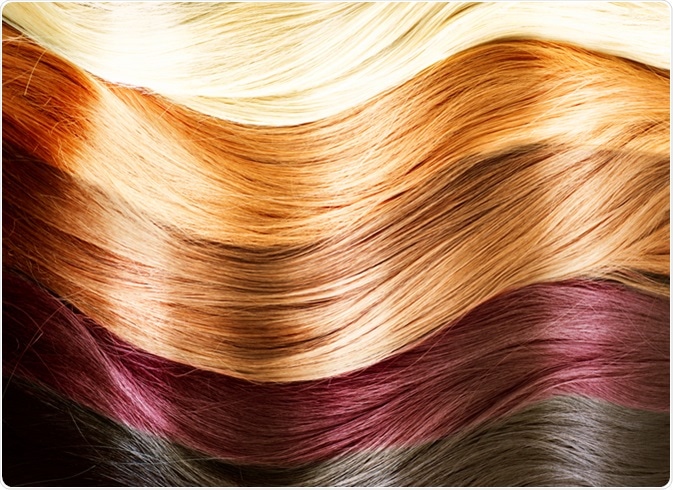Hair color is the phenotypic modification of genes related to hair that shows noticeable variations within humans.
Generally, hair colors are classified into dark and light in which the former is predominant. The knowledge of melanocyte biology can lead us to the genes involved in hair color.
All the colors of hair are mostly associated with a single class of pigments called melanin.

Hair Colors Palette. Hair Texture. Image Credit: Subbotina Anna / Shutterstock
Melanin
Melanins are pigments derived from an amino acid called tyrosine. The color of the hair depends on the amount and type of melanin produced by melanocytes. Melanocortin 1 Receptor (MC1R) is the gene responsible for hair color determination.
It is found on the surface of melanocytes and also in other cells and play a role in the immune function in humans. There are three types of natural melanin.
They are:
Eumelanin
When MC1R is in the active condition, it produces eumelanin, which causes dark hair. It is also responsible for the protection of skin from damage by ultraviolet radiation.
Pheomelanin
When MC1R is in an inactive condition, the melanocytes will produce pheomelanin, which causes light or red hair. This pigment lacks the feature of protecting the skin from sunlight.
Neuromelanin
Since it is found in dopamine neurons, it colors some areas of the brain, which has no direct relation with hair color.
Mutation of neuromelanin may result in a neurodegenerative disorder, which has an indirect relation with hair color.
Genes Liable to Hair Color
Predominantly, human hair can be of five different colors: black, brown, blond, white/gray, and rarely red. Among these major colors, different shades also exist.
Black Hair Color
Black is the commonly seen hair color in Asia and Africa due to the fact that the people in these regions tend to have lower levels of tyrosinase in their bodies.
Black eumelanin secretion causes the hair to turn black, which indicates that the MC1R is in the active state.
Brown Hair Color
Human hair in brown color is seen in many shades like brown-ebony, brown-mahogany, brown-oak, etc.
These many shades of brown are due to the presence of an allele, a specific variation in the gene that is found at the specific spot on the chromosome.
For example, people with brown-ebony shaded hair have some alleles that catalyze the enzymes to produce a large amount of brown pigment.
Some alleles in people with brown-Swedish blond suppress the enzyme production, which in turn causes less production of brown pigment. Based on this allele-enzyme activity, the shade of brown hair color differs.
Blond Hair Color
Blond hair is formed when there is a presence of lower quantity of brown eumelanin with the absence of other pigments. People with blond hair color are mostly seen in European countries.
The genome-wide association studies (GWAS) has found that the mutant gene that is responsible for blondness in the Northern European population is KIT ligand (KITLG), which has an ability to fight skin cancer.
KIT ligand along with other genes is responsible for the mutation of skin color, blood stem cells, and sperm.
Genes involved in the pigment production contain single-nucleotide polymorphisms (SNP) or the adenine guanine nucleotide, which alters the amount of KITLG present in the hair follicle.
The mutation of the SNP or adenine-guanine nucleotide has been marked as a potential element of blond hair phenotype.
Red Hair Color
The red hair color is very rare around the world. They are found in Northern Europe, specifically in Britain and Ireland. The gene present in red hair is recessive.
The red color is caused by a series of mutations in the MC1R gene, which transmits to the hair more pheomelanin; this also results in pale skin.
The arrangement of amino acids in the protein for red-haired people differs from that in people having other color hair.
Red-haired people suffer a lot due to a higher risk of sunburns and skin cancer, since the pheomelanin does not protect the skin from sunlight. People with red hair genes are more prone to skin cancer.
The ultraviolet radiation from sunlight instantly triggers the MC1R gene to get mutated and also increases the stage of mutation in the tumor.
Scientists have found that people with two MC1R alleles are more likely to have melanoma than those with one MC1R variant gene.
The variant MC1R gene has decreased the synthesis of dopamine neurotransmitter in the brain; thus red-haired people require a larger amount of anesthetic and are very conscious of thermal pain.
Chromosome 16 - Genetically ginger
White or Gray Hair
Hair that lacks melanin pigments become white. Thus, white hairs completely lack both eumelanin and pheomelanin pigments.
White-haired people reflect light due to the optical activity of the color. Mostly, colored hair turns white or gray as the melanocyte activity stops.
Scientists have discovered that the gene responsible for gray hair is the "Interferon regulatory factor 4" (IRF4), which plays a role in the production and storage of melanin.
Further Reading